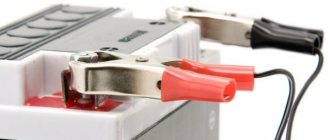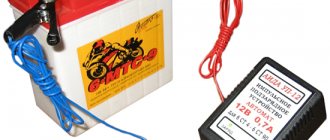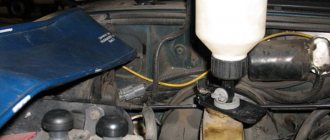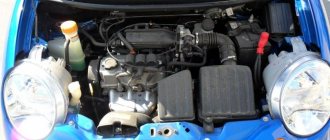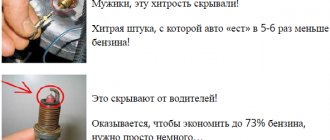Why is current leakage dangerous?
Loss of current leads to rapid battery discharge, wiring fires and other problems. The causes of the leak may be:
- Using a damaged battery;
- Deformation of insulation in wiring;
- Oxides and dirt on conductive terminals;
- Incorrect connection of devices to the machine electronics;
- Small charge supply from the generator.
To prevent such situations from arising, regularly check the battery, recharge it and, if necessary, replace it.
Summarizing
How to check leakage current on a car battery using a multimeter? There are no exact instructions for action. Regardless of why the charge leak occurs. You should not ignore this problem, even if everything is fine with you. For peace of mind and confident operation of the car, purchase a multimeter, starting leads and a set of car keys.
These inexpensive devices will help you save a lot of time, nerves and money, since any problem is most easily solved if you know about it in advance. Check the battery and generator periodically, and you will not find yourself in a situation where you urgently need to start the car, but this is impossible for certain technical reasons. Good luck on the roads and do not forget about the Rules of the Road.
Diagnosing leaks with a multimeter
To check whether there is a loss of current, you need a multimeter, an open-end wrench, wires with clamps, and protective rubber gloves. Before checking, turn off all electrical consumers. Then turn off the ignition and remove the key. In the engine compartment, loosen the negative terminal with a wrench. Remember to close the car doors but leave the windows open, as the central locking may be activated if the power is turned off. Next, follow these steps to check for leaks.
- Set the multimeter to 10 A current measurement mode.
- Make a circuit break: connect the negative terminal to the ammeter wire.
- Connect the second wire to the negative terminal of the battery.
- Set the current.
Do not forget that you cannot connect wires to the positive and negative terminals. This will result in a short circuit and failure of the fuse.
The measurement standard is 0t 15 to 65-70 A. If a larger number is detected, then it is necessary to find a leak.
Finding the leak
Leakage often occurs due to network congestion. This happens when a car has many non-standard devices installed. Therefore, leak testing usually starts with them.
- Set the multimeter to ammeter mode.
- Disable each non-staff and regular device in turn. Record all multimeter readings.
- If standard current readings are detected, inspect the equipment that has been disconnected.
If no leak is found in the equipment, check the condition of the battery, leads and other elements again.
Normal value of battery leakage current
Modern cars have electrical devices that must function even when the car is idle with the ignition off. In this case, the only electrical source is not the generator, but the battery. The planned energy is spent on maintaining such consumers. These include, for example, an alarm system, a clock or an on-board computer with sensors.
For certain consumers, the manufacturer sets a certain planned leakage current from your car’s battery (the norm is indicated below). The alarm takes about 18–26 mA, and the clock takes up to 2 mA.
The permissible approximate current for leakage from the battery to the dashboard is set at 2–3 mA. The interior lighting consumes about 11 mA, and the headlight consumes up to 50 mA.
The average leakage current for a modern passenger car is set at 20–80 mA.
Checking the Wiring Condition
Sometimes leakage occurs due to damaged wiring. The wiring of non-standard equipment is often damaged. This happens because the wires of the additional equipment are positioned incorrectly: they are in contact with the engine block or bracket. This can damage the insulation and cause a short circuit, leakage or fire.
Check the alarm wires, door structures, wiring under the seats. In these areas, abrasion can occur due to the continual closing and opening of the circuit. Set the alarm to the required mode and monitor the readings on the ammeter. If the current remains the same, continue testing.
Troubleshooting a real problem
The situation that will be described in this article actually happened to one of the so-called “masters of garage cooperatives.” We brought the classic and asked to fix the problem associated with the rapid “death” of the battery. Well, then in order.
Let's figure out how to detect a current leak in our car. To do this, we need a multimeter that measures current up to 10A.
We set the measuring device to the DC current measurement mode. Insert the wire plugs into the corresponding sockets on the device.
Generator control
The generator may be to blame for the current leak. It happens that the generator does not transmit impulse to the battery after ignition. Check the generator by following the diagram.
- Turn off the ignition and remove the key.
- Turn off power consumers.
- Connect the wires from the multimeter to the battery, taking into account the correspondence between minus and plus.
- Use voltmeter mode. The reading should be 12.9 V.
- Check the voltage (increases to 14 V).
If lower voltage is detected, have the alternator checked by a workshop. Using special equipment, they will determine the presence of faults and defects.
Other reasons for battery discharge
What to do if the driver measures the current consumption and it does not exceed the norm? As mentioned above, difficult starting after a long period of parking may not be caused by leakage currents. Some of the most common causes of this problem may include:
- High battery self-discharge.
- Generator malfunction.
Testing the battery for self-discharge
To determine the condition of the battery, you need to remove it from the car and wipe it clean with a rag soaked first in a solution of baking soda, then in water.
If the battery is serviceable, you need to check the density and electrolyte level in each section (there are 6 in total). The battery is then fully charged by the mains charger to normal voltage (12.7 V without load). All that remains is to leave the unconnected battery for several days and then measure the voltage at the terminals again. If the voltage loss is more than 0.2 V, then the problem is in the battery. You will have to buy a new battery or try to restore the damaged one, at least temporarily, by contacting the appropriate specialists. If the battery “holds”, then either the problem has been eliminated (for example, water was added to semi-dry jars), or the problem is different.
Checking the functionality of the generator
The problem may also be in the generator, which simply does not charge the battery when the engine is running. Of course, almost every car has a warning light that comes on if the battery is not charging. But it can also deceive if, for example, there is a charging current, but it is too small. In this case, the battery is not able to replenish the energy spent on starting the engine, and when a powerful load is turned on (headlights, heaters, etc.) it may even begin to discharge.
To check the serviceability of the generator, you will need the same tester (multimeter), but now operating in DC voltmeter mode.
The multimeter switch must be set to constant voltage , the measurement limit is not lower than 20 V.
First of all, it is necessary to measure the voltage at the battery terminals with the ignition off. For example, let it be equal to 12.7 V (battery is fully charged).
Voltage on the battery when the ignition is turned off (use a different type of multimeter).
Now you need to start the engine at idle speed, and turn off all consumers (headlights, radio, heaters, etc.). The voltage at the battery terminals should rise to 13.8 - 14.5 V (depending on the state of charge of the battery).
The voltage on the battery is sufficient to charge it when consumers are disconnected.
Now you need to connect energy-intensive consumers - headlights, heater/air conditioner, heated windows/seats, radio, etc. The voltage at the battery terminals should drop to 13.5-13.7 V.
The generator copes with the load and continues to charge the battery.
If it is lower, then the generator cannot cope with the load, and you will have to repair it. But that's a completely different story.
Never check the serviceability of the generator by disconnecting the battery while the engine is running. This method was suitable 30 years ago, when all the electrical equipment of the car consisted of a kilometer of wire and five relays. Modern car electronics will not forgive such an experiment. In addition, simply “throwing off” the terminal will not indicate a malfunction if the generator is running, but its voltage is not enough to charge the battery.
How to keep your battery healthy
If the leakage current reaches high levels, the battery discharges faster. Frequent discharges in a lead-acid battery provoke the deposition of salt compounds on the terminals and plates. The working area is reduced and battery performance deteriorates. When the salts begin to crystallize, the battery fails. To avoid this, you must:
- Test the battery periodically;
- Clean the battery case and conductive terminals;
- Check the condition of wires, terminals, clamps and fasteners;
- Recharge the battery regularly;
- Monitor the level and density of the electrolyte.
And if you need a new battery, come to Delmex!
Leakage current in a car: what you need to know
If we consider leakage current, we must take into account that this phenomenon is present to a greater or lesser extent on many cars. This depends both on the design features and on the installation features of various additional equipment.
For example, on many VAZ models the leakage currents are initially large. The fact is that the power system on some models of domestic cars is not fully thought out; a large number of consumers do not turn off after the driver removes the key from the ignition switch.
As a result, consumers use up charge even when the car is closed. Of course, in new models (for example, Lada Vesta), this problem has been eliminated, but the presence of additional devices and non-standard equipment can still lead to such solutions draining the battery. The main reason is that if you install certain devices incorrectly, there is a high risk of battery consumption even after the device is turned off. Let's figure it out.
- First of all, the causes of current leakage can be associated with both standard and non-standard equipment. In other words, the following may fail or malfunction: a generator, a starter, an audio system, a standard alarm system, etc. Often problems arise with wiring.
As a rule, problems with the starter (for example, a starter with a stuck bearing) are expressed not only in the fact that the starter turns poorly. In such a situation, this device will greatly discharge the battery every time the engine is started.
If the trips are short, then it will simply not be possible to restore the charge from the generator. Of course, after several starts of the engine with a faulty starter, the battery will be discharged.
However, in practice, such problems more often arise on old cars or cars with high mileage, the units and components of which are quite worn out.
- As for more “fresh” or fully operational cars, in this case there are usually current leaks due to the installation of third-party equipment. For example, the battery can be severely discharged by an alarm system or security system, radio tape recorders, amplifiers, subwoofers, video recorders, GPS navigators, various heating systems, connected chargers for all kinds of devices, etc.
It is important to understand that the problem cannot be ignored. A deep discharge of the battery will damage even a new battery! The fact is that acid batteries with an electrolyte of sulfuric acid and distilled water are most often used. So, during a discharge, sulfuric acid in the form of salts settles on the plates; the salts turn into crystals and do not dissolve.
The result is a drop in battery capacity several times, a decrease in starting current and loss of performance. It turns out that the battery should not be allowed to be deeply discharged, which cannot be achieved if there is a current leak.
What current leakage is normal?
A car has a large number of different electrical consumers (the wiring itself, relays, various controllers, etc.). Also, the “minus” of the battery is screwed to the body (ground). The body itself has static energy, which also leads to leakage.
One way or another, there will be a current leak even on a fully functional car. The main thing is that it fits within the acceptable values. Please note that the indicators for different cars will differ (depending on the size of the car, its equipment, etc.) A small current leakage from 15 to 75 or even 80 mA can be considered the norm. Usually, on average, the leakage is about 40 milliamps.
If the leakage current is several hundred milliamps or even amperes, then it is necessary to carry out diagnostics, since in this case such a leakage current clearly indicates problems.
